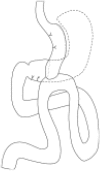Efficiency and risks of one-anastomosis gastric bypass
- PMID: 32309411
- PMCID: PMC7154323
- DOI: 10.21037/atm.2020.02.03
Efficiency and risks of one-anastomosis gastric bypass
Abstract
The single-anastomosis gastric bypass has been proposed as a simpler and efficient weight loss reducing surgery. Postoperative outcomes are comparable to those of contemporary popular procedures. There are, however, controversies regarding the efficiency and risks of one-anastomosis gastric bypass (OAGB). The purpose of this review is to define the role of OAGB in metabolic surgery via its operative outcomes. A review of English language literature was performed using the PubMed database, basing the search on the following keywords: "one-anastomosis gastric bypass" AND "outcomes". A total of 238 articles were considered for review. Following thorough screening and selection criteria, 7 articles were considered sufficient for assessment. The nature of the available evidence of this technique poses a challenge to OAGB in its establishment as a standard of care procedure. The anatomical configuration following surgery, as well as the metabolic implications of its hypo-absorptive nature, raises controversial and ongoing concerns that are yet to be addressed. Hence, prospective studies with long-term follow-up (>5 years) can bypass these concerns and allow the progression of the clinical practice of OAGB.
Keywords: One-anastomosis gastric bypass (OAGB); bariatric surgery; mini gastric bypass; obesity; single anastomosis gastric bypass; weight loss.
2020 Annals of Translational Medicine. All rights reserved.
Conflict of interest statement
Conflicts of Interest: The focused issue “Bariatric Surgery” was commissioned by the editorial office without any funding or sponsorship. The authors have no conflicts of interest to declare.
Figures
References
-
- Adult Obesity Facts. Overweight & Obesity. Available online: https://www.cdc.gov/obesity/data/adult.html
-
- Jensen MD, Ryan DH, Apovian CM, et al. 2013 AHA/ACC/TOS guideline for the management of overweight and obesity in adults: a report of the American College of Cardiology/American Heart Association Task Force on Practice Guidelines and The Obesity Society. Circulation 2014;129:S102-38. 10.1161/01.cir.0000437739.71477.ee - DOI - PMC - PubMed
-
- Estimate of Bariatric Surgery Numbers, 2011-2017. American Society for Metabolic and Bariatric Surgery. In: American Society for Metabolic and Bariatric Surgery. Available online: https://asmbs.org/resources/estimate-of-bariatric-surgery-numbers
Publication types
LinkOut - more resources
Full Text Sources
Medical


